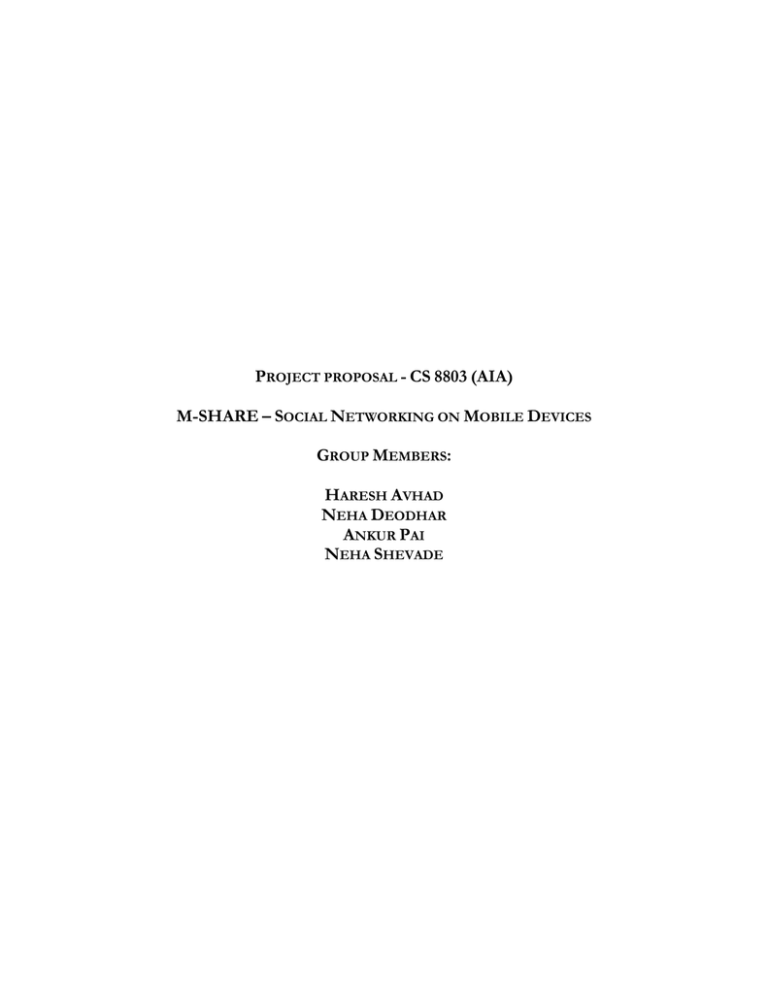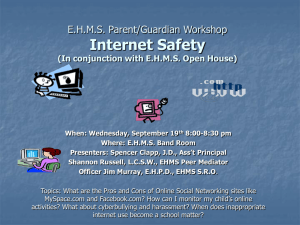P - CS
advertisement

PROJECT PROPOSAL - CS 8803 (AIA) M-SHARE – SOCIAL NETWORKING ON MOBILE DEVICES GROUP MEMBERS: HARESH AVHAD NEHA DEODHAR ANKUR PAI NEHA SHEVADE MOTIVATION AND OBJECTIVES With the increasing popularity of the internet, Social Networks have become one of the most upcoming areas in the interactive computing field. Social Networking websites allow people with common interests to connect with one another, build online profiles, chat and share photos, videos and music. Sites such as Facebook and MySpace have gained widespread popularity in recent years. They provide an exciting way for people to make new friends as well as keep in touch with older friends. Another technology that has become widely popular is mobile technology. Mobile phones began to proliferate in the 1990s and allow people to remain in touch wherever they are. Today, practically every person has a mobile phone. Advances in this field allow users to send messages to one another, share photos and videos (using Bluetooth technology), connect to the internet and a variety of other features. Combination of these two technologies would certainly be extremely beneficial and as expected, “mobile social networking” is hyped to be the next big thing. Mobile social networks enable individuals with common interests to converse and connect with one another using mobile phones. This allows users to remain in touch with each other and get the latest updates without actually logging into the social networking websites. Currently, mobile social networking tools provide users with short text messages when new comments or friend requests are posted to their profiles. It would be great to take this idea further and allow individuals to exchange information which includes text messages, photos, videos, music etc. using mobile phones. For example, it will be nice if we could set up an impromptu meeting with a group of friends or forward some photo that has been taken on the cell phone immediately to people who might be interested in it. We propose building a “mobile info sharing application” that would enable users to share messages, photos, music and videos. At present, this sharing is possible using Bluetooth technology. However, this requires users to be present close to one another. Our application will let users connect and instantaneously exchange information with each other regardless of where they are and without requiring them to log into their social networking profiles. RELATED WORK In a web based social network, one or more individuals of similar interests or commonalities, converse and connect with one another. A few years back, the idea of social networks was extended to mobile phones. This provides all the features of web-based social networks on an individual’s cellular phone. Under the Cingular deal subscribers get short text messages when new comments or friend requests get posted to their MySpace profile. Also, special phones called Helio phones include applications that make it easy for customers to view friends' profiles and post comments and photos onto MySpace. This was the first step of adding social networks to mobile applications. Using this as a baseline, another cellular company called Rave Wireless came up with a mobile social networking application that allows students to connect to their teachers, faculty, fellow students and even the campus security. Faculty and teachers can notify students about changes in assignments or schedule for the class. Students can also conduct online chats with their professors. Also, in case of emergency, security alerts can be provided to all the students. Students can also collaborate with each other by sharing files with one another. Currently, there are various applications which allow their users to upload photos and videos from their mobile phones to some photo sharing application on the web. Examples of these are ShoZu, Treemo, Yahoo! Go Flickr etc. Each of these applications allow their users to upload their photos and videos to photo sharing applications like Picasa, SnapFish, Treemo etc. Pickle is another photo sharing mobile application which allows users to load their photos to a central spot and then distribute the photos to all the people subscribed to Pickle. PROPOSED WORK Social Networking Services (SNS) are increasing in popularity day by day. They encourage users to communicate with previously unknown network members on an unprecedented scale. With the advent of technologically sound mobile phones, social networking through mobile phones is the requirement of the highly advanced and rapidly moving technological world. We are proposing to develop a mobile device based application that enables lightweight, groupcentric real-time communication as well as photo and video sharing. The core concept of our project is that, a group of people can exchange messages, photos and videos. The information from the sender will be sent to a server, from which it will be propagated to the users subscribed to that particular group. One point to note is that the users can be members of multiple groups. The architecture used for the project would be Client-Server architecture. The main features of our project are outlined as follows: Ability to send messages, photos and videos to a group Public and Private groups: The groups can be public as well as private. Public group means that you can search for groups of interest by keyword and join them. Here, the administrator needs to provide permission for a user to join the group. Private group means that you must receive an invitation from a group moderator/member to see the group and join it Users will have the facility of viewing messages per group Senders will be able to filter out members from a particular group before sending data Receivers will also be able to filter out members from whom they don’t want to receive data There will be an upper bound on the size limit allowed to send data We also need to conform to a standard format for different file types in each category viz. messages, photos, videos If for some reason there is not enough space available on the server/client i.e. the server/client is overloaded, then we need to maintain a buffer to store the data temporarily and repeatedly send data until success or for a maximum number of attempts There will be facility to create a new group. The group creator can choose members who can join the group Users can change their user names whenever they wish to Users can also quit a particular group We plan to implement all the above mentioned functionalities. Many successful attempts have been made to implement social networking on mobile devices as stated in the related work section but integrating all the stated features with cellular phones and keeping into mind the social networking aspect of it, the proposed project is certainly a novel idea and an extension to an existing technology. Architectural Design SERVER Sharing N/W Sharing N/W D Sharing N/W C B A (Receiving Clients) (Sending Client) C B (Receiving Clients) (Message sent to only selected few of the entire group) (Entire Group receiving the message) PLAN OF ACTION We plan to use the following technologies. Software: Google Android Java Eclipse 3.2 Platform: Microsoft Windows Schedule: Week Feb 18 – Feb 24 Feb 25 – March 9 March 10 – March 23 March 24 – April 6 April 7 – April 13 Proposed Work Introduction to Android Development of client side functionalities for information exchange Development of server functionalities Implementation of Additional Features such as filtering etc. Documentation EVALUATION AND TESTING The project will be tested and evaluated on the following factors: Scalability The amount of requests that the server can handle at a time, without loss of information provided by any of its clients will be measured. This will depend on the amount of memory available at the server in order to handle large number of requests. Evaluation will also be done on how the server addresses the problem when there isn’t enough memory on the cell phone of the receiving client to receive the sent items. Time and Space Evaluation The amount of time required to send the photo or video files from the sending client to the receiving client will be evaluated. This will depend on the size of the file that is being sent and also on the server load. The average time will be calculated and efforts will be made to improve this value. Also the maximum size of the file which can be sent by the client will be evaluated. A tradeoff will be made between the time required to send a file and the maximum size of the file to achieve better performance. We plan to evaluate our project using testing methods such as unit testing, stress testing etc. BIBLIOGRAPHY [1] Information on mobile social networking http://en.wikipedia.org/wiki/Mobile_social_network [2] Google Android, http://code.google.com/android/ [3] Pickle – a photo sharing application, www.pickle.com [4] MySpace Mobile, http://www.myspace.com/attmyspacemobile [5] Rave Wireless – A campus mobility application, http://www.ravewireless.com/ [6] Albrecht Schmidt, Paul Holleis, Jonna Häkkilä, Enrico Rukzio, Richard Atterer, “Mobile Phones as Tool to Increase Communication and Location Awareness of Users”, ACM International Conference Proceeding Series; Vol. 270, Proceedings of the 3rd international conference on Mobile technology, applications & systems


